How to enjoy low light indoor plants — no green thumb required
Any room can benefit from a little greenery. If the idea of keeping a plant alive seems daunting, you may be surprised to know that many low light indoor plants are easy to care for and can withstand a bit of neglect. This means you can still embrace Mother Nature by selecting leafy green friends that fit your space and lifestyle. If you want to find out what plants you can easily care for in your own home, read on!
Top 5 Low Light Indoor Plants:
Sansevieria (Snake Plant)
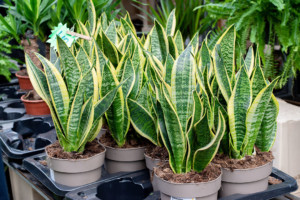
Low light indoor plants like the Snake Plant (seen above) are some of the easiest houseplants to take care of.
Adorned with sword-like leaves and a yellow-green striped pattern, these green perennials are one of the easiest houseplants to take care of. They can soar anywhere from eight inches all the way to 12 feet high, and require very little maintenance. Snake plants are considered succulents and are very forgiving, making them the perfect beginner plant. They require:
- Indirect sunlight
- Shady corners of the house
- Very little water
- Drier soil
Terra cotta pots are great for snake plants, as they allow the soil to dry out more easily than a plastic pot. When choosing a potting mix, one designed for cacti and succulents is ideal, as it will be more resistant to overwatering.
Hoya carnosa (Wax Plant)
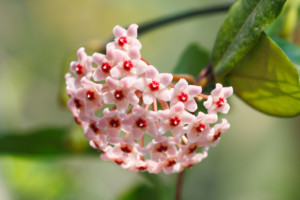
Low light indoor plants like the Wax Plant have been popular house plants for decades due to their low-maintenance requirements.
The Hoya carnosa has been a popular house plant for decades due to its low-maintenance requirements. These plants have a long lifespan, deep green vining leaves and produce light pink and red star-shaped flowers. Because of their thick and waxy leaves, they are often called wax plants. A few tips on caring for this blooming plant include:
- Do not water them too often, every one to two weeks is fine
- They can tolerate low light and humidity
- The soil must be completely dry before watering again
- They thrive in indirect sunlight
For potting this waxy wonder, soil with good air circulation is highly recommended. Hoya like to be crowded in their pots and will only need to be repotted every two or three years. As they are tropical plants that thrive in humid conditions, using a humidifier to bring the humidity levels up is a great idea when caring for this flowering plant.
Ficus elastica (Rubber Fig)
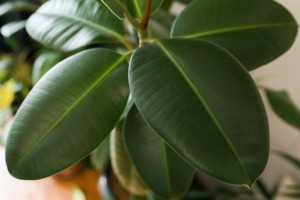
The Rubber Plant is a low light indoor plant that does not need much attention to stay healthy.
These grand, dark green plants decorated with glossy leaves are extremely forgiving. Their large, rubbery leaves might need an occasional wipe-down to get rid of dust or water spots, but generally, they don’t need much attention. Here are a few notes on how best to take care of them:
- They should be repotted once every couple of years
- They can tolerate many different soils
- They can withstand low-light conditions
- They generally require water once a week
In their native environment, these plants grow in areas where humidity is a constant. Therefore, to prevent potential problems and keep them producing healthy new growth, try to replicate humidity while they’re growing indoors through air humidifiers.
Dracaena Marginata (Dragon Tree)
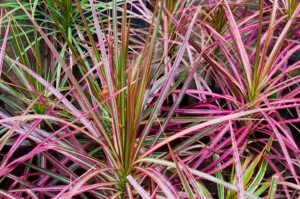
The Dragon Tree is one of the best examples for indoor plants’ low light lenience.
These low maintenance and vibrant plants have years of longevity. With elegantly long, thin leaves and red edges, they are useful for providing height to a room and are simple to tend to. Keep in mind:
- They prefer a bright or lightly shaded spot but can also tolerate lower light levels
- They like moist compost but are tolerant of erratic watering
- Wipe the leaves occasionally to keep them dust free and shiny, pulling any that have shriveled up
Monstera Deliciosa (Split-leaf Philodendron)
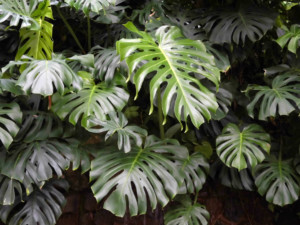
The Monstera Deliciosa is a low light indoor plant that is easy to take care of.
Filled with evergreen vines and shrubs, Monstera Deliciosa plants are native to Central America. These tropical plants are famous for their distinctive splits and cutouts on their dark glossy leaves, providing the nickname of the “Split-leaf” Plant. When caring for this plant, remember these tips:
- They require bright to medium indirect light
- They can tolerate a little drought
- Their soil should be lightly moist
- They can adapt to many different environments
These indoor plants prefer well-draining porous pots, such as terracotta or clay, because they like airflow and drainage. However, any material pot with drainage holes will work just fine.
Low Light Indoor Plants are one of Our Specialties
Feeling extra challenged in the plant care game or just don’t have the time to care for indoor plants yourself? Plant Solutions can provide you with beautiful, lush indoor plants while also helping you maintain those green goddesses through our signature horticultural services. We offer pleasant, punctual and expert plant maintenance by one of our horticultural specialists so that all the work is in our hands!
